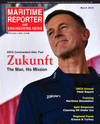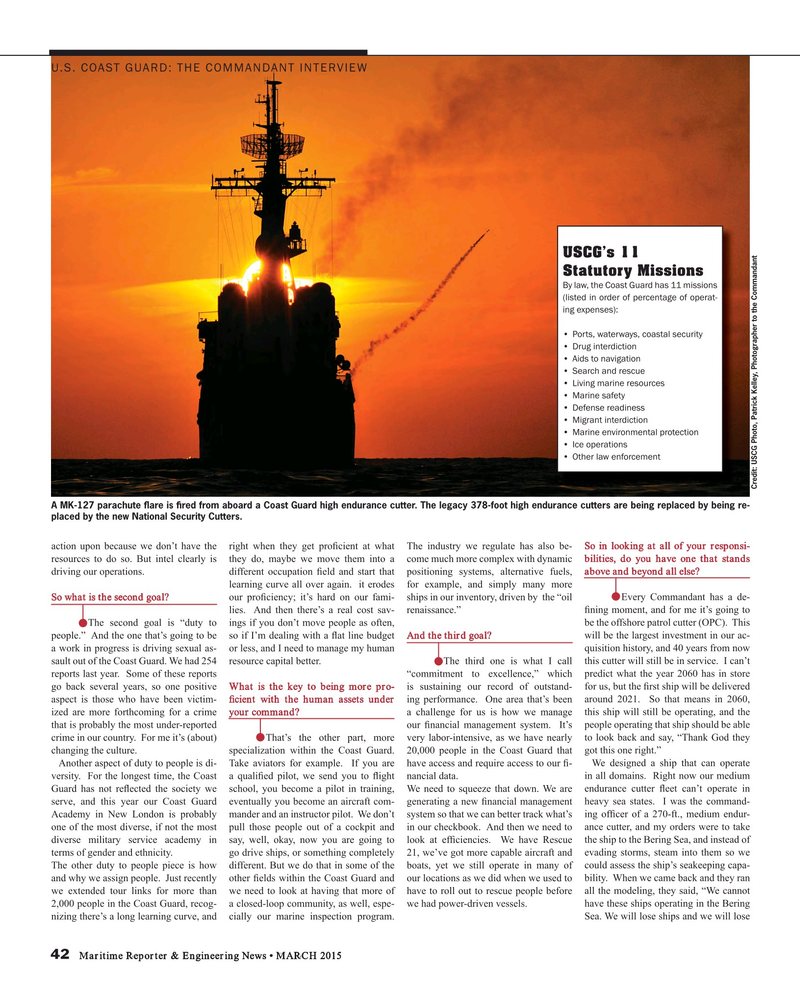
Page 42: of Maritime Reporter Magazine (March 2015)
U.S. Coast Guard Annual
Read this page in Pdf, Flash or Html5 edition of March 2015 Maritime Reporter Magazine
U.S. COAST GUARD: THE COMMANDANT INTERVIEW
USCG’s 11
Statutory Missions
By law, the Coast Guard has 11 missions (listed in order of percentage of operat- ing expenses): • Ports, waterways, coastal security • Drug interdiction • Aids to navigation • Search and rescue • Living marine resources • Marine safety • Defense readiness • Migrant interdiction • Marine environmental protection • Ice operations • Other law enforcement
Credit: USCG Photo, Patrick Kelley, Photographer to the Commandant
A MK-127 parachute ? are is ? red from aboard a Coast Guard high endurance cutter. The legacy 378-foot high endurance cutters are being replaced by being re- placed by the new National Security Cutters. action upon because we don’t have the right when they get pro? cient at what The industry we regulate has also be- So in looking at all of your responsi- resources to do so. But intel clearly is they do, maybe we move them into a come much more complex with dynamic bilities, do you have one that stands driving our operations. different occupation ? eld and start that positioning systems, alternative fuels, above and beyond all else?
learning curve all over again. it erodes for example, and simply many more
So what is the second goal? our pro? ciency; it’s hard on our fami- ships in our inventory, driven by the “oil Every Commandant has a de- lies. And then there’s a real cost sav- renaissance.” ? ning moment, and for me it’s going to The second goal is “duty to ings if you don’t move people as often, be the offshore patrol cutter (OPC). This people.” And the one that’s going to be so if I’m dealing with a ? at line budget And the third goal? will be the largest investment in our ac- a work in progress is driving sexual as- or less, and I need to manage my human quisition history, and 40 years from now sault out of the Coast Guard. We had 254 resource capital better. The third one is what I call this cutter will still be in service. I can’t reports last year. Some of these reports “commitment to excellence,” which predict what the year 2060 has in store go back several years, so one positive What is the key to being more pro- is sustaining our record of outstand- for us, but the ? rst ship will be delivered aspect is those who have been victim- ? cient with the human assets under ing performance. One area that’s been around 2021. So that means in 2060, ized are more forthcoming for a crime your command? a challenge for us is how we manage this ship will still be operating, and the that is probably the most under-reported our ? nancial management system. It’s people operating that ship should be able crime in our country. For me it’s (about) That’s the other part, more very labor-intensive, as we have nearly to look back and say, “Thank God they changing the culture. specialization within the Coast Guard. 20,000 people in the Coast Guard that got this one right.”
Another aspect of duty to people is di- Take aviators for example. If you are have access and require access to our ? - We designed a ship that can operate versity. For the longest time, the Coast a quali? ed pilot, we send you to ? ight nancial data. in all domains. Right now our medium
Guard has not re? ected the society we school, you become a pilot in training, We need to squeeze that down. We are endurance cutter ? eet can’t operate in serve, and this year our Coast Guard eventually you become an aircraft com- generating a new ? nancial management heavy sea states. I was the command-
Academy in New London is probably mander and an instructor pilot. We don’t system so that we can better track what’s ing of? cer of a 270-ft., medium endur- one of the most diverse, if not the most pull those people out of a cockpit and in our checkbook. And then we need to ance cutter, and my orders were to take diverse military service academy in say, well, okay, now you are going to look at ef? ciencies. We have Rescue the ship to the Bering Sea, and instead of terms of gender and ethnicity. go drive ships, or something completely 21, we’ve got more capable aircraft and evading storms, steam into them so we
The other duty to people piece is how different. But we do that in some of the boats, yet we still operate in many of could assess the ship’s seakeeping capa- and why we assign people. Just recently other ? elds within the Coast Guard and our locations as we did when we used to bility. When we came back and they ran we extended tour links for more than we need to look at having that more of have to roll out to rescue people before all the modeling, they said, “We cannot 2,000 people in the Coast Guard, recog- a closed-loop community, as well, espe- we had power-driven vessels. have these ships operating in the Bering nizing there’s a long learning curve, and cially our marine inspection program. Sea. We will lose ships and we will lose 42 Maritime Reporter & Engineering News • MARCH 2015
MR #3 (42-49).indd 42 MR #3 (42-49).indd 42 3/6/2015 12:00:46 PM3/6/2015 12:00:46 PM

 41
41

 43
43
